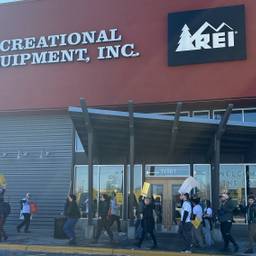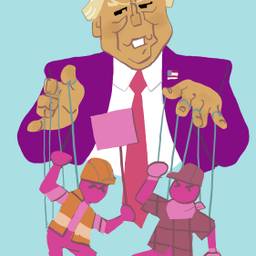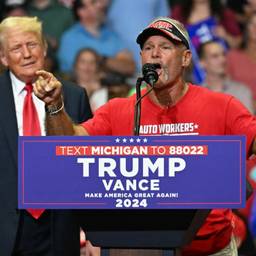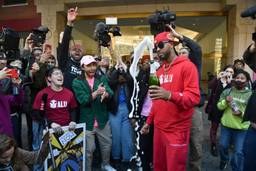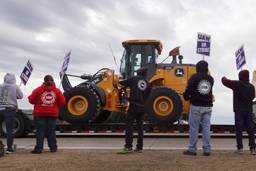The Right Believes It Has the Supreme Court Votes to Overturn Labor Law
Unions need to plan a response now.
Shaun Richman

The foundational 1935 labor law protecting workers is unconstitutional, according to major corporations and right-wing zealots who believe they have enough votes on the Supreme Court to overturn it. In the latest sign that anti-union forces will doggedly press the matter, a federal judge for the Northern District of Texas enjoined the National Labor Relations Board (NLRB) from processing any allegations of employer violations of workers’ rights. The National Review hailed the decision as “A Welcome Blow to the NLRB.”
This is after Elon Musk’s SpaceX won a similar injunction against the NLRB before the Western District of Texas in July. Both cases will work their way up to the Fifth Circuit Court, which has served as an expressway to steer anti-regulatory legal appeals to the Supreme Court ever since Trump packed it with right-wing ideologues.
The arguments that the employers utilize, and even the immediate outcomes of these cases, are almost irrelevant to the ultimate goal: The right wing aims to repeal the 20th Century.
But, in trying to repeal all the rights and protections workers gained during the New Deal, including the limited protections that workers currently enjoy for organizing and engaging in collective bargaining, killing the 1935 National Labor Relations Act (also known as the Wagner Act) would also mean the lifting of a host of restrictions on unions’ ability to carry out solidarity activism and effective economic sanctions.
Are unions prepared for a return to “the law of the jungle?”
Here’s what the bosses in these cases are arguing: The National Labor Relations Board is unconstitutional because its staff — the administrative law judges (ALJ’s) who are tasked with investigating and litigating violations of the Act — were improperly appointed.
Basically, ALJ’s are hired by the National Labor Relations Board itself, a five-member body established by the act. Board members are nominated by the president and confirmed by the Senate, and serve staggered terms so that the board’s 3-2 partisan majority lags behind but eventually lines up with the party in power in the White House. As such, the argument goes, the ALJ’s are too removed from public accountability to be fair judges.
This was the logic that the Supreme Court applied to the Securities and Exchange Commission in last term’s SEC v Jarkesy, which hobbled the power of the agency’s administrative law judges to levy fines. So, in some respects, the high court is already inviting a challenge to all similarly structured federal agencies, including the NLRB. But the Court’s first inclination may be to chip away at the labor board’s power, while the activist Right will keep trying to seize the opportunity to nullify the existence of the country’s main enforcer of workers’ rights.
University of Minnesota law professor Charlotte Garden doesn’t see any of the current Texas cases resulting in the total nullification of the NLRB. “What’s more likely,” she says, if the Supreme Court agrees with the Jarkesy argument, “is that the Court severs the good-cause provisions of the statute,” allowing ALJ’s and even Board members to be fired for any reason. “That’s what passes for optimism these days,” she ruefully adds.
Severing one part of the law deemed to be unconstitutional while allowing the rest of the act to remain on the books is exactly how the Supreme Court handled last term’s challenge to the Wagner Act, Starbucks Corp. v. McKinney. In that case, the Court “merely” diluted the NLRB’s power to seek speedy injunctions in cases of egregious union-busting during union election campaigns. The bosses won that case in an 8-to-1 vote, with Justices Elena Kagan and Sonia Sotomayor going along with the majority — showing that judicial hostility to unions extends to many Democratic appointees, potentially making nullification of the right to organize an easier lift than overturning the right to abortion.
Most employers raising these challenges aren’t out to change the law of the land but are “motivated by their usual desire for delay tactics,” Garden explains. Win or lose, delays – including the litigation of violations of the act – leave up to 43% of newly certified unions still fighting for a first contract after two years, according to one recent study.
Whatever employers’ immediate goals, these tactics have knock-on effects. Starbucks, which has an evolving labor peace deal with Workers United, the union that’s organizing its employees, stresses on its website that it is not joining SpaceX in challenging the constitutionality of the NLRB. But actions that Starbucks set in motion during its union-busting campaign still threaten the heart of labor law. In a September 18 hearing before the Third Circuit Court of Appeals in Philadelphia, Republican judges peppered Starbucks attorneys with questions about Jarkesy in a case in which the company is fighting NLRB-ordered financial reimbursements for retaliatory terminations against union activists.
And throughout the country, the National Right To Work Foundation is “challenging the constitutionality of the NLRB with free legal representation” for scab Starbucks workers who were previously encouraged by their employer to fight the union.
Between all of these challenges, it’s likely that one or more circuit courts will rule the NLRB either partially or totally unconstitutional within the next six months, potentially putting an appeal on the Supreme Court docket as soon as October 2025. Regardless of the outcome, it’s clear that the forces of reaction are lining up case after case, and the arguments really don’t matter. They have their 6-3 majority on the Supreme Court, and they’re insisting that their bought-and-paid-for politicians in black robes vote as they are told.
Are unions preparing to lose both the protections – and the shackles – of the NLRB?
Two years into Ronald Reagan’s assault on workers’ rights, AFL-CIO President Lane Kirkland mused that labor might be “better off with the law of the jungle” if the NLRB was simply scrapped instead of having its mission twisted by movement conservatives.
“We’re the only exception to industry craving deregulation,” he said. “Let us go mano a mano. I think we could organize very rapidly.”
Kirkland was no radical militant, but his bluff was obliquely referring to a host of union protest tactics – from boycotts and partial or intermittent strikes to sit-down strikes and sabotage – that had been surrendered in exchange for government protections of the right to collective bargaining.
Before 1935, fights for union recognition often were pitched battles. Employers used spies, blacklists and armed Pinkertons. Unions fought back with mass picket lines and boycotts, and often destruction of property. Bosses usually prevailed because they had more guns and deeper pockets.
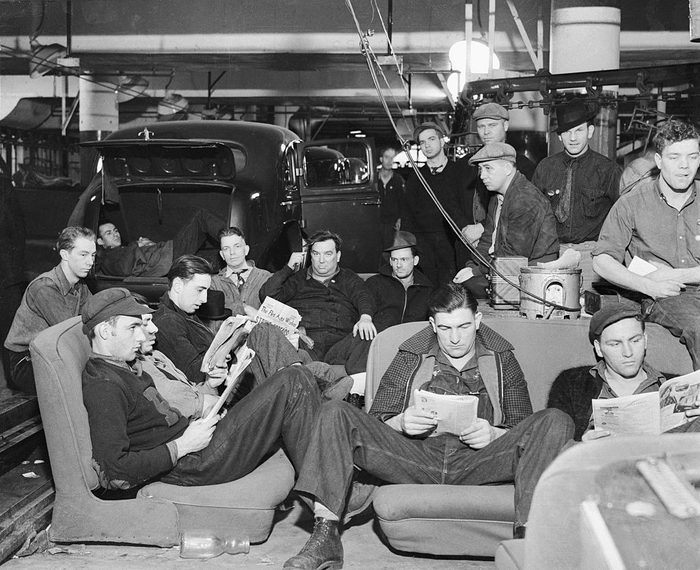
The National Labor Relations Act domesticated labor relations. It committed the federal government to protecting and encouraging the practice of collective bargaining, legally compelling employers to recognize and bargain “in good faith” with representative unions. The law protects workers from being fired or blacklisted for joining, organizing or voting for a union. It also prevents bosses from forming company unions or bribing union leaders. Employer violations are known as unfair labor practices, or ULP’s. The federal agency tasked with policing the law, the NLRB, is relatively toothless but can gain enforcement powers by taking recalcitrant employers to court (which is how the SpaceX and Starbucks cases got into court and on the way to the Supreme Court in the first place).
Unions accepted this framework. Many, if not most, employers eventually accepted it as well, especially as soon as the NLRB and the courts used the framework to remove the protections of the law from some of the labor movement’s most effective tactics. Most famously, and early on, the Supreme Court removed protections for workers who engaged in sit-down strikes in 1939’s NLRB v. Fansteel. Unions complied by dropping sit-down strikes from their arsenal, largely because the remaining protections of the law were still advantageous to making huge organizing gains. Union density grew from 11.5% before the Wagner Act was passed to 34.2% by 1945.
But employers, through their favorite politicians and judges, continued to constrict the range of protected union tactics. The 1947 Taft-Hartley amendment to the Act severely restricted unions’ ability to engage in solidarity activism (dryly called “secondary activity” in the law), such as boycotts of an anti-union company.
Imagine unionized grocery store workers refusing to uncrate boxes of Oreo cookies made at non-union factories, or Teamsters refusing to deliver Budweiser beer to non-union hotels. The power of solidarity can be enormous, which is why they made solidarity boycotts illegal (under the law they’re now trying to overturn).
But, if no union activity is protected because the NLRB ceases to exist, then all union tactics are potentially valid, or at least morally defensible, as long as unions are ready to fight back proportionally.
“I don’t think a lot of labor folks are focused on this right now,” says Stephen Lerner, a fellow at Georgetown University’s Kalmanovitz Initiative for Labor and the Working Poor, and an architect of Bargaining for the Common Good. “Unions are more focused on defeating Trump in the election, and on their current organizing and bargaining fights.” Regardless of the outcome of the election, Lerner says, “This is the culmination of a 50-year anti-union agenda and they’re going for it precisely at the moment that the labor movement is popular and on the move.”
To fight back against the right-wing assault and thrive in this era, Lerner says, “We should be prepared to revive the tactics that built union power in the first place.” Garden agrees, saying that without the NLRB, unions could “focus on what is strategically the best call, and not just what is protected.”
Seven years ago, I outlined a number of union activities that are, or should be, protected by the constitutional rights of free speech, due process, equal protection and even the Thirteenth Amendment’s ban on “involuntary servitude,” but were instead traded away by the regulatory approach of the NLRB. At the time, “Labor’s Bill of Rights” was an argument to engage in a campaign of judicial activism to reverse bad NLRB decisions. If the Supreme Court nullifies the NLRB, it should be added to the list of actions that unions should undertake in the aftermath.
Unions are most likely to respond to a federal reversal on labor law by trying to pass copycat Wagner Acts in pro-union states like California, Minnesota and New York. That’s not a terrible strategy, but framers of the new laws should take a “clean slate” approach to their lawmaking, taking the opportunity to strip deference to bad past precedents in case law, restoring any concerted worker protest activity to protection from employer retaliation, and streamlining state agency processes to ensure speed and prioritization of disputes in new union organizing cases.
Although the 1932 Norris-La Guardia Act, which prohibits federal judges from enjoining union picket lines, would remain on the books, making it — on paper, at least — the primary federal policy statement on private sector labor relations, we would see wide divergences between red and blue states in the treatment of union organizing.
However unions respond, Stephen Lerner cautions that time is of the essence. “Whatever we do that’s effective, if it’s not already illegal, they’ll rush to make it illegal.” Lerner points to UAW President Shawn Fain’s proposal to line up 2028 contract expirations and align union bargaining demands with community and political demands in a general strike as the kind of planning that should be taking place now.
Assuming that the Supreme Court sticks to its cowardly practice of dumping its most unpopular decisions in the last week of the term in which it hears arguments, we have 20 months until the NLRB is shut down. In some ways, that is a luxurious amount of lead time for unions, which are capable of a tremendous amount of coordination. But debate and discussion need to begin now, not one year from now when the Supreme Court majority tips its hand during oral arguments. The right wing could not be clearer about their intentions. We must be ready.
Shaun Richman is a labor expert at SUNY Empire State University and author of Tell The Bosses We’re Coming: A New Action Plan for Workers in the 21st Century.
